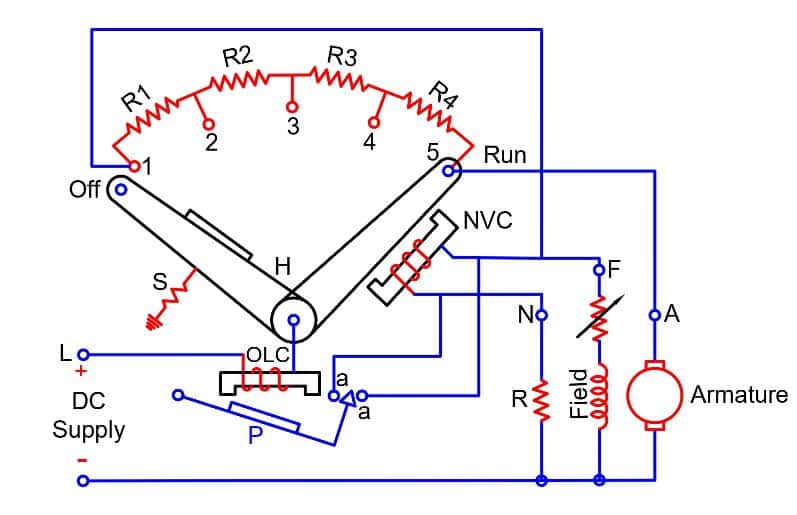The 4-Point Starter is almost identical in performance features to the 3-Point Starter. It limits the starting current in a DC motor in the absence of back EMF(Eb) and functions as a protective device.
Working Principle of 4 Point Starter
The DC motor takes a high starting current because the back EMF is absent at the start. A 4-point starter limits the starting current by increasing the armature resistance at the start & protects the armature of a DC motor.
Construction & Operation of Four Point Starter
The four-point starter is very similar to the three-point starter. Their construction and functional similarities are almost the same. Now let us discuss in detail the operation of the Four-point starter.
The diagram for the 4-point starter is shown below.

- ‘L’ line point connected to positive supply
- ‘A’ Armature terminal point
- Field winding connected to NVC(‘ F’ point)
- Resistance(R) connected to NVC ( ‘N” point)
Where – NVC is the no-volt coil
The starter has the contact points – studs- and is shown separately as OFF, 1, 2, 3, 4, 5, and RUN, over which we can regulate the starting current of the motor by operating the handle manually.
Initially, the starter handle is in the off position. In this condition, the motor’s armature does not receive supply. Now, when we put the handle at stud ‘1’, the armature of the motor connects in the series with R1, R2, R3 & R4. Thus, the total resistance of the armature at stud position 1 is;
R(Armature circuit Resistance) = (R1 + R2 +R3 + R4 ) + Ra
Thus, the total armature resistance is maximum when we start the motor. Why is maximum resistance in series with armature resistance needed at the motor’s starting? There is no back EMF at the starting, and series resistance can only limit the starting current.
Now, as the motor accelerates, the series resistance decreases, and at stud position ‘5, ‘ the motor runs at its rated speed.
R(Armature circuit Resistance) = Ra
The table below shows how the resistance decreases with a change in the stud position of the starter.
| Stud Postion | Armature Circuit Resistance |
| 1 | R1+R2+R3+R4+Ra |
| 2 | R2+R3+R4+Ra |
| 3 | R3+R4+Ra |
| 4 | R4+Ra |
| 5 | Ra |
How does the handle remain stuck in position 5?
When you supply the voltage to a no-volt coil, it energizes. During the energizing period, the NVC attracts the soft magnetic piece attached to the handle. It will keep the handle in its last position until the supply is available and the motor current is within its rated current.
When power is cut, the motor armature must be disconnected from the supply source. If it is not disconnected, the motor will start by taking an enormously high current when the supply is restored.
How does the 4-point starter protect the motor under overload?
When the motor takes more current than its rated current, the overcurrent relay operates. The contact of the overload relay shorts the supply across the no-volt coil, demagnetizing it. The no-volt coil can no longer attract the magnetic piece mounted on the handle, so the handle goes to its OFF position. This way, the starter protects the motor armature from burning.
Difference between 4-point & 3-point Starter
Although their operational characteristics are the same, there is some difference between the 3-point and 4-point starters. A 4-point starter has no holding coil in its shunt field circuit. The holding coil is connected across the line with a current-limiting resistor.